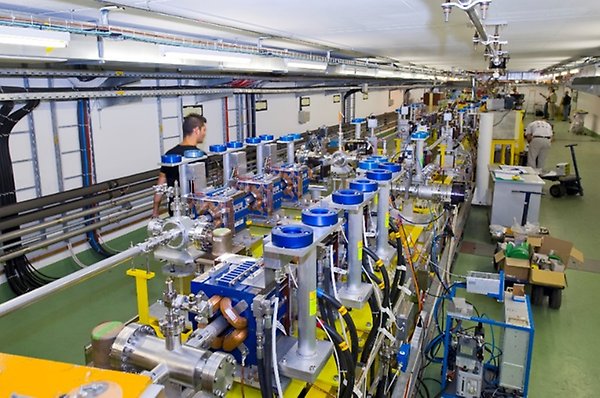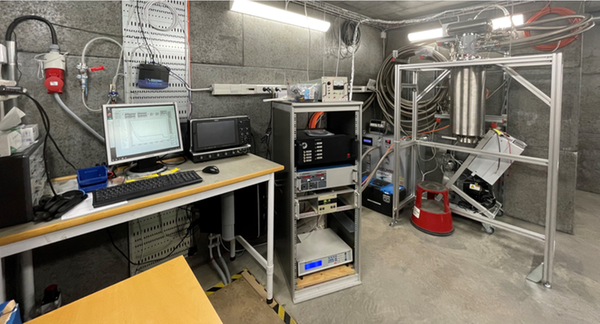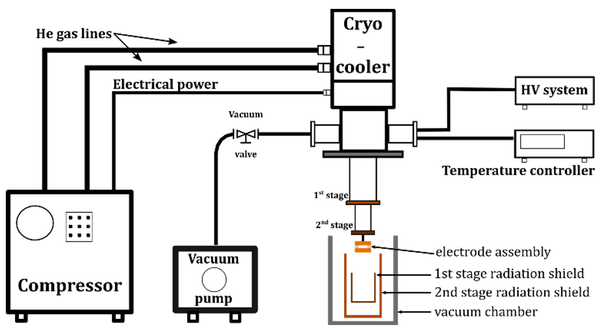CLIC
The Compact Linear Collider (CLIC) study is an international collaboration working on a concept for a machine to collide electrons and positrons (antielectrons) head-on at energies up to several Teraelectronvolts (TeV). This energy range is similar to the LHC’s, but using electrons and their antiparticles rather than protons, physicists will gain a different perspective on the underlying physics.

CLIC conceptual drawing
The aim is to use radiofrequency (RF) structures and a two-beam concept to produce accelerating fields as high as 100 MV per meter to reach a nominal total energy of 3 TeV, keeping the size and cost of the project within reach.
The two-beam acceleration scheme envisioned in CLIC was extensively studied in the Two-beam Test-stand (TBTS), part of the CLIC Test Facility CTF3 at CERN. A high frequency electron beam (the drive beam) is sent to a Power Extraction Structure (PETS). The PETS transfers the extracted beam energy into an RF structure where it is used to accelerate the so called probe beam. Beam stability, beam loss issues as well as PETS and RF structures will be studied in this set-up.

RF Breakdown studies for CLIC
After the successful start of the LHC accelerator at CERN, we expect many years of discoveries that could lead to better understanding of the universe. Accelerator physicists however continue to plan for future facilities where more detailed studies of particle physics secrets can be done at higher energies. CLIC, the Compact Linear Collider, is the proposed successor to the LHC. In the CLIC particles are accelerated by a very strong electric field. Unfortunately, large electric fields can lead to vacuum discharges which in turn can affect the particle beam and lead to reduced performance of the CLIC accelerator. Studies of the physics behind vacuum discharges and its effect on the beam is therefore an important issue we are investigating in Uppsala.


Publications
Test summary for the 061 RFQ Soft Cu samples tested in cryogenic DC system
2024
'Newton' fast shutter system for neutron scattering instruments at the ESS and ISIS neutron sources
Part of Nuclear Instruments and Methods in Physics Research Section A, 2023
- DOI for 'Newton' fast shutter system for neutron scattering instruments at the ESS and ISIS neutron sources
- Download full text (pdf) of 'Newton' fast shutter system for neutron scattering instruments at the ESS and ISIS neutron sources
Accelerator development at the FREIA Laboratory
Part of Journal of Instrumentation, 2021
Statistical Analysis of Field-Emission Currents
Part of Physical Review Applied, 2021
- DOI for Statistical Analysis of Field-Emission Currents
- Download full text (pdf) of Statistical Analysis of Field-Emission Currents
Part of ND 2019, 2020
- DOI for Gamma spectroscopy methodology for large amounts of environmental samples in Sweden 30 years after the Chernobyl accident
- Download full text (pdf) of Gamma spectroscopy methodology for large amounts of environmental samples in Sweden 30 years after the Chernobyl accident
Part of Physical Review Applied, 2020
- DOI for Temperature-Dependent Field Emission and Breakdown Measurements Using a Pulsed High-Voltage Cryosystem
- Download full text (pdf) of Temperature-Dependent Field Emission and Breakdown Measurements Using a Pulsed High-Voltage Cryosystem
Citizen Science and Radioactivity
Part of Nuclear Physics News, p. 25-28, 2019
- DOI for Citizen Science and Radioactivity
- Download full text (pdf) of Citizen Science and Radioactivity
Cryosystem for DC spark experiments: Construction and acceptance tests
2019
Dark currents studies with the Uppsala X-band Spectrometer at XBox test stand at CERN
2019
Part of Proceedings of FEL2017, Santa Fe, NM, USA, 2017
Part of Proceedings of the 8th International Particle Accelerator Conference (IPAC 2017), Copenhagen, Denmark, May, 2017, 2017
Kontextrika problem för effektiv problemlösning i en avancerad mekanikkurs
Part of Proceedings från 6:e Utvecklingskonferensen för Sveriges ingenjörsutbildningar, 2017
Working with context rich problems to teach problem solving
Part of Transforming patterns through the scholarship of teaching and learning, 2017
Spectrometers for RF breakdown studies for CLIC
2016
Spectrometers for RF breakdown studies for CLIC
Part of Nuclear Instruments and Methods in Physics Research Section A, p. 63-71, 2016
ESS RF Source and Spoke Cavity Test Plan
2015
PROGRESS AT THE FREIA LABORATORY
Part of Proceedings of IPAC'15, 2015

